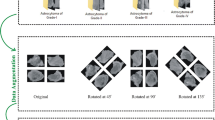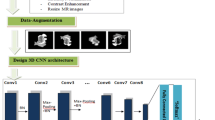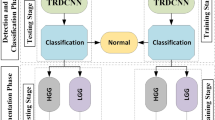Abstract
Glioma is among aggressive and common brain tumors, with a low survival rate, in its highest grade. Invasive methods, i.e., biopsy and spinal tap are clinically used to determine the grades of glioma. Depending upon the findings of these methods, treatment is planned to improve the life expectancy of the controls. Magnetic resonance imaging (MRI), the most widely used medical imaging modality to diagnose a brain tumor, is producing a huge volume of MRI data. A reliable, automatic, and noninvasive method of glioma grading are always required as an alternative to these invasive methods. In this research, a model has been proposed using Convolutional Neural Networks to classify low and high-grade glioma. A locally organized dataset, developed in the Department of Radiology (Diagnostics), Bahawal Victoria Hospital, Bahawalpur, Pakistan has been used for research and experiments. Additionally, results have also been validated on a publicly available benchmarked dataset, i.e., BraTS-2017. The proposed method demonstrated significant achievement in terms of classification rates, i.e., the accuracy of 98.93% (for low-grade glioma) and 98.12% (for high-grade glioma). Experimental results proved that the proposed model is accurate (98.52%) and is efficient in glioma grade identification.





Similar content being viewed by others
References
Attique M et al (2012) Colorization and automated segmentation of human T2 MR brain images for characterization of soft tissues. PLoS ONE 7(3):e33616
Bartheld CS, Bahney J, Herculano-Houzel S (2016) The search for true numbers of neurons and glial cells in the human brain: a review of 150 years of cell counting. J Comp Neurol 524(18):3865–3895
Chen Q et al (2019) Glioma grade predictions using scattering wavelet transform-based radiomics. arXiv preprint arXiv:1905.09589
Chen Q et al (2020) Glioma grade prediction using wavelet scattering-based radiomics. IEEE Access 8:106564–106575
Ertosun MG, Rubin DL (2015) Automated grading of gliomas using deep learning in digital pathology images: A modular approach with ensemble of convolutional neural networks. In: AMIA Annual Symposium Proceedings. American Medical Informatics Association
Gilanie G et al (2013) Object extraction from T2 weighted brain MR image using histogram based gradient calculation. Pattern Recognit Lett 34(12):1356–1363
Gilanie G et al (2018) Classification of normal and abnormal brain MRI slices using Gabor texture and support vector machines. Signal Image Video Process 12(3):479–487
Gilanie G et al (2019) Computer aided diagnosis of brain abnormalities using texture analysis of MRI images. Int J Imaging Syst Technol 29(3):260–271
Gilanie G et al (2021) Risk-free WHO grading of astrocytoma using convolutional neural networks from MRI images. Multimed Tools Appl 80(3):4295–4306
He K et al (2017) Mask r-cnn. In: Proceedings of the IEEE international conference on computer vision
KV AM, Rajendran V (2019) Glioma tumor grade identification using artificial intelligent techniques. J Med Syst 43(5):113
Louis DN et al (2007) The 2007 WHO classification of tumours of the central nervous system. Acta Neuropathol 114(2):97–109
Majno G, Joris I (2004) Cells, tissues, and disease: principles of general pathology. Oxford University Press, Oxford
Mankin HJ, Lange TA, Spanier S (1982) The hazards of biopsy in patients with malignant primary bone and soft-tissue tumors. JBJS 64(8):1121–1127
Nyúl LG, Udupa JK, Zhang X (2000) New variants of a method of MRI scale standardization. IEEE Trans Med Imaging 19(2):143–150
Pan Y et al (2015) 37th Annual International Conference of the IEEE Engineering in Medicine and Biology Society (EMBC). IEEE
Priya KM, Kavitha S, Bharathi B (2016) Brain tumor types and grades classification based on statistical feature set using support vector machine. In: Intelligent Systems and Control (ISCO), 10th International Conference on. 2016. IEEE
Reza SM et al (2019) Glioma grading using structural magnetic resonance imaging and molecular data. J Med Imaging 6(2):024501
Rizwan M et al (2022) Brain tumor and glioma grade classification using gaussian convolutional neural network. IEEE Access
Sajjad M et al (2019)Multi-grade brain tumor classification using deep CNN with extensive data augmentation. J Comput Sci 30:174–182
Subashini MM et al (2016) A non-invasive methodology for the grade identification of astrocytoma using image processing and artificial intelligence techniques. Expert Syst Appl 43:186–196
Tearney GJ et al (1997) In vivo endoscopic optical biopsy with optical coherence tomography. Science 276(5321):2037–2039
Tripathi PC, Bag S (2022) A computer-aided grading of glioma tumor using deep residual networks fusion. Comput Methods Programs Biomed 215:106597
Tustison NJ et al (2010) N4ITK: improved N3 bias correction. IEEE Trans Med Imaging 29(6):1310–1320
Vamvakas A et al (2019) Imaging biomarker analysis of advanced multiparametric MRI for glioma grading. Physica Med 60:188–198
Wang X et al (2019) Machine learning models for multiparametric glioma grading with quantitative result interpretations. Front Neurosci 12:1046
Weiss S, Langloss J, Enzinger F (1983) Value of S-100 protein in the diagnosis of soft tissue tumors with particular reference to benign and malignant Schwann cell tumors. Lab Invest 49(3):299–308
Author information
Authors and Affiliations
Corresponding author
Ethics declarations
The authors declare that they have no known competing financial interests or personal relationships that could have appeared to influence the work reported in this paper.
Additional information
Publisher’s Note
Springer Nature remains neutral with regard to jurisdictional claims in published maps and institutional affiliations.
Rights and permissions
About this article
Cite this article
Gilanie, G., Bajwa, U.I., Waraich, M.M. et al. An automated and risk free WHO grading of glioma from MRI images using CNN. Multimed Tools Appl 82, 2857–2869 (2023). https://doi.org/10.1007/s11042-022-13415-9
Received:
Revised:
Accepted:
Published:
Issue Date:
DOI: https://doi.org/10.1007/s11042-022-13415-9




